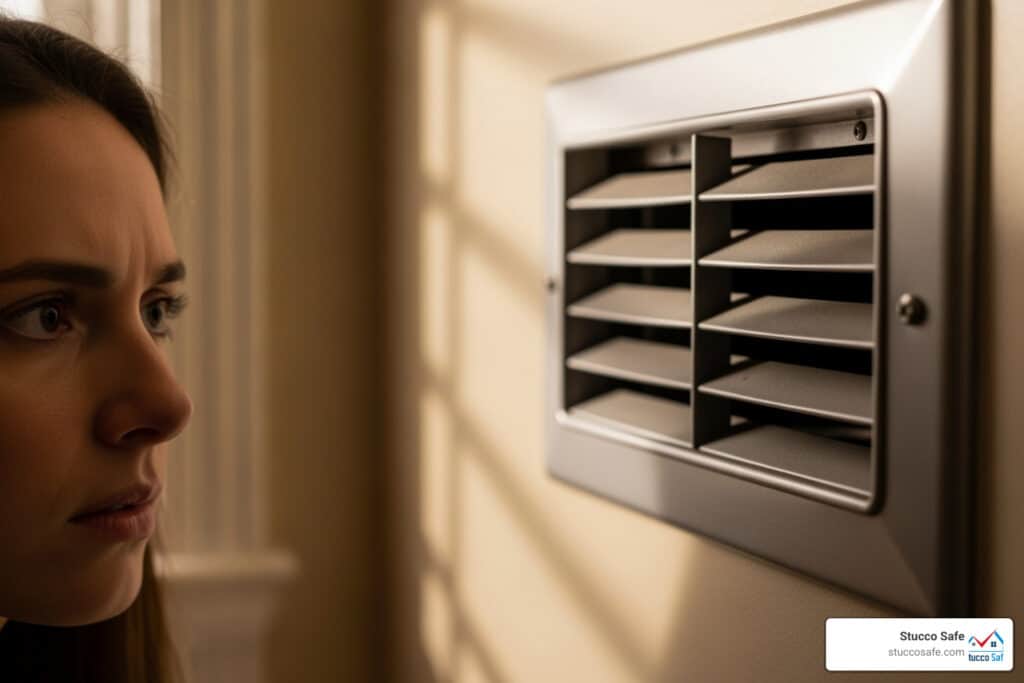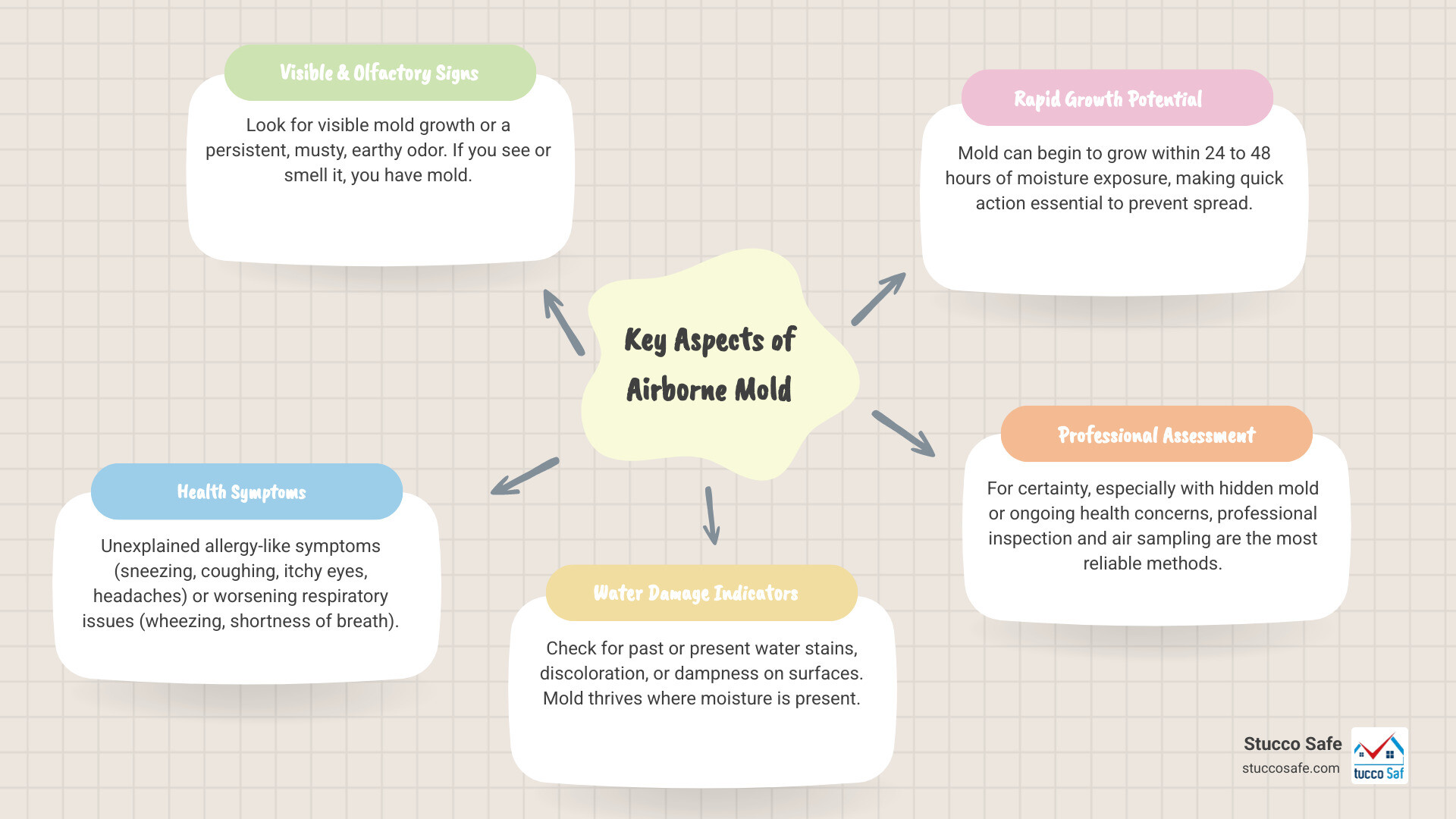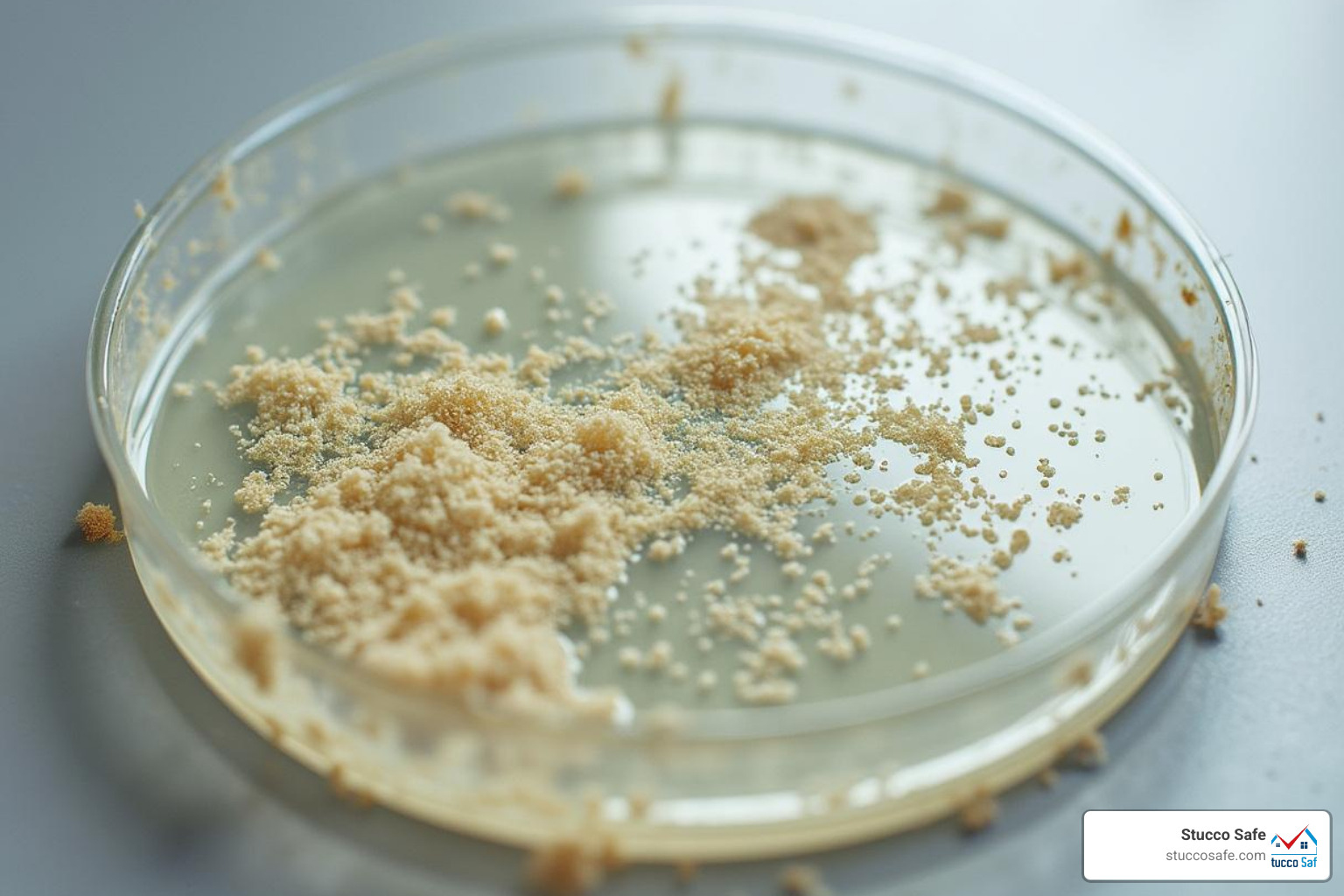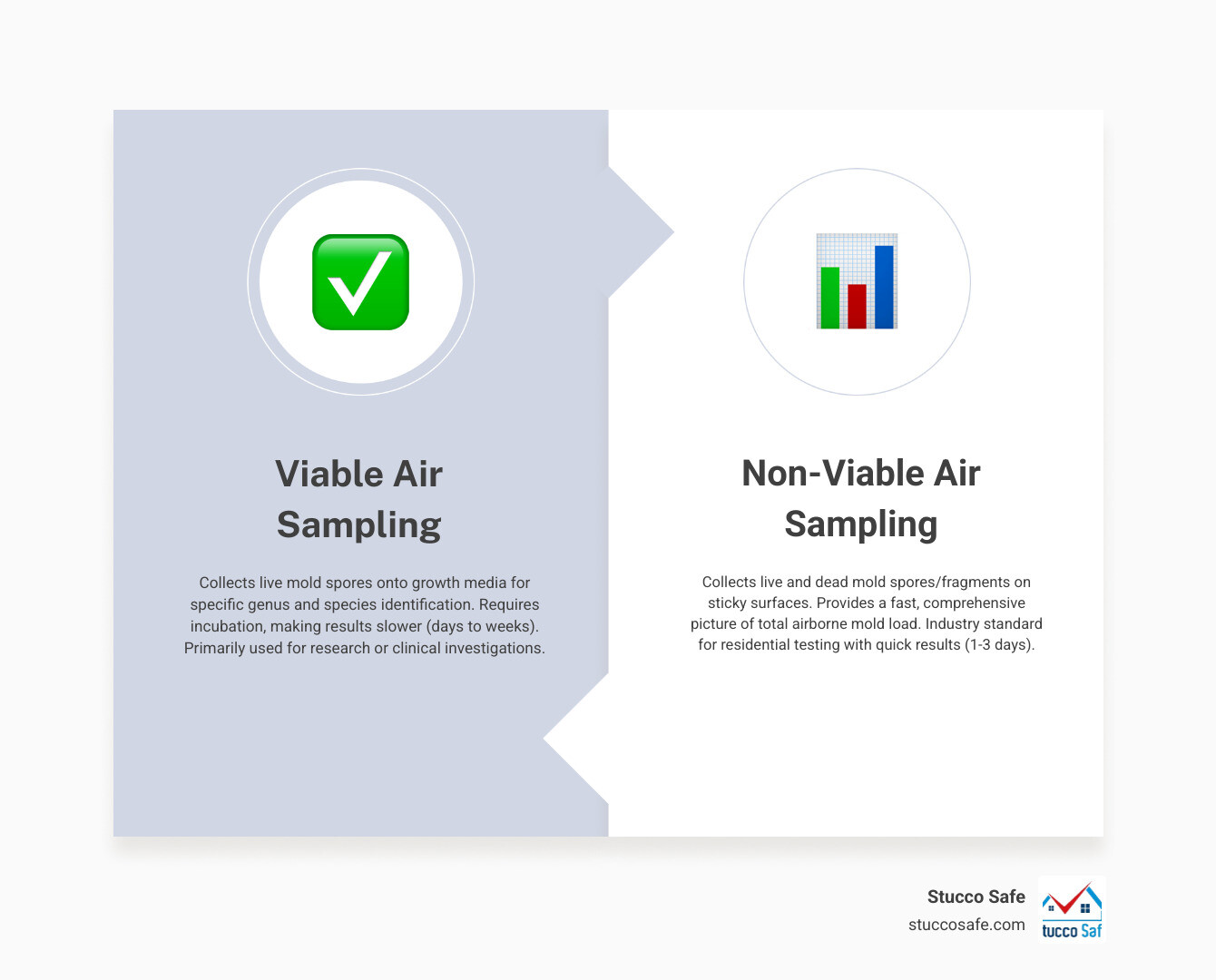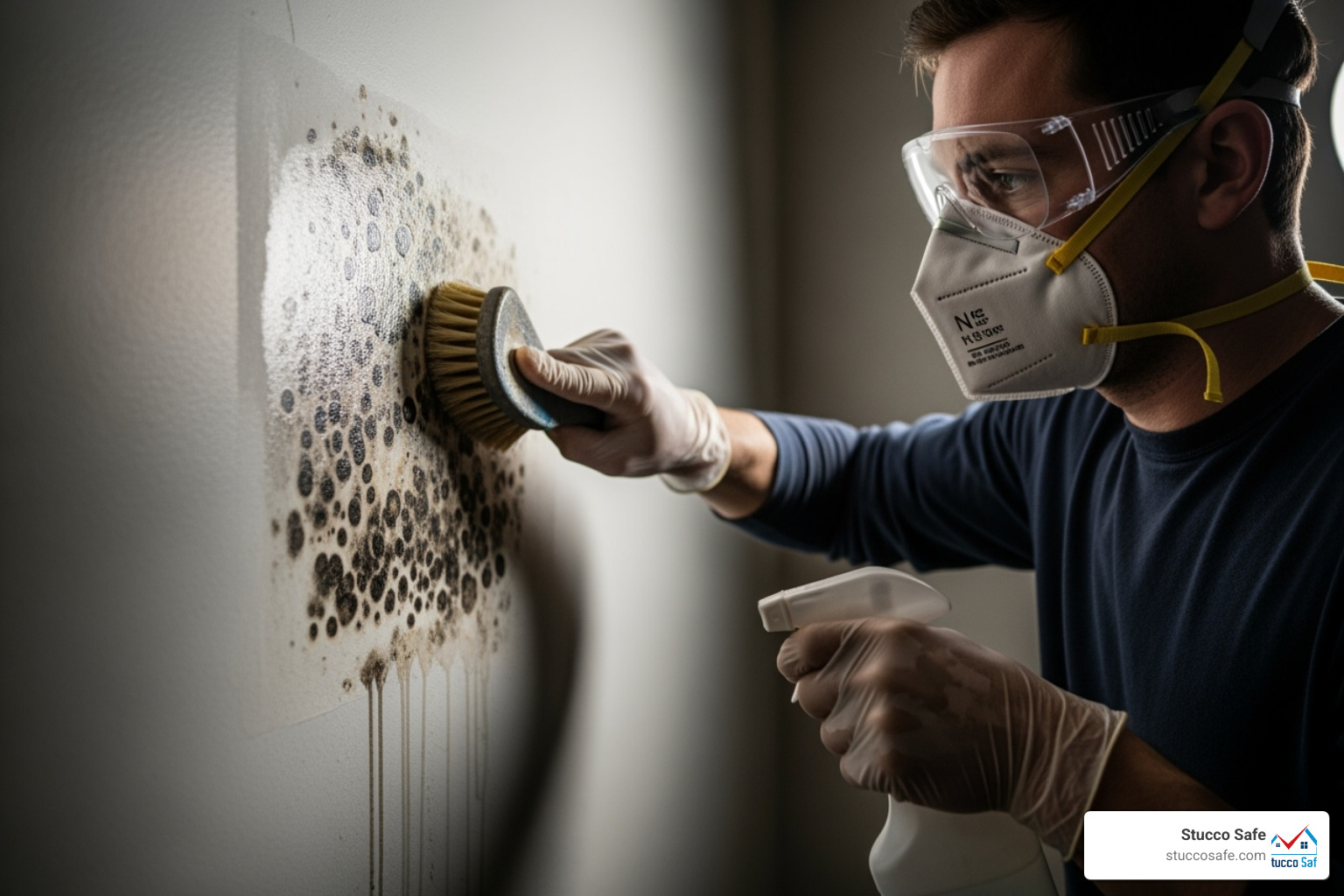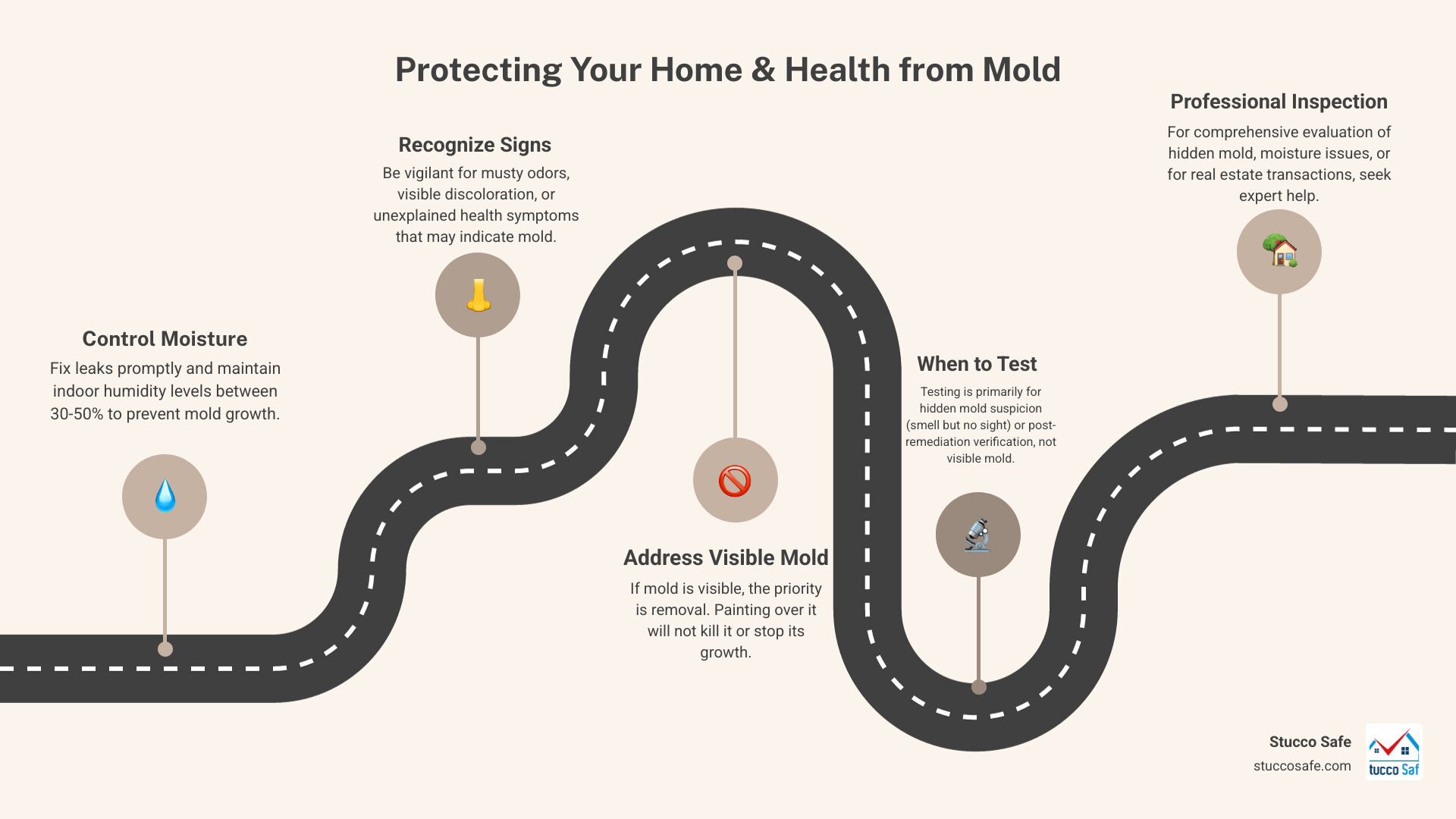Check for mold in air: Protect Your Home 2025
Understanding Airborne Mold
Suspecting unseen mold in your home and deciding to check for mold in air is a smart step towards a healthier living environment. Airborne mold can cause issues from unpleasant odors to health problems, so identifying its presence is key.
Here’s a quick guide:
- Use Your Senses: Visible mold growth or a persistent, musty odor are clear signs.
- Note Health Symptoms: Unexplained allergy-like symptoms (sneezing, coughing) that improve when you leave home can point to airborne mold.
- Find Water Damage: Look for water stains, discoloration, or dampness. Mold thrives on moisture.
- Get a Professional Assessment: For certainty with hidden mold or health concerns, professional inspection and air sampling are the most reliable methods. Mold can grow within 48 hours of moisture exposure.
I’m Gabe Kesslick, and with over two decades in leak detection, I know how crucial it is to check for mold in air. My experience addressing moisture issues is the foundation for understanding and tackling airborne mold.
Recognizing the Signs and Health Risks of Airborne Mold
A strange, earthy smell or feeling ‘off’ in a room can be clues that mold is growing in your home. Mold releases tiny spores into the air, and breathing them in can impact your health.
For many, mold spores trigger allergy symptoms like sneezing, a runny nose, coughing, headaches, and itchy eyes. For those with asthma, it can worsen breathing, causing wheezing and shortness of breath. Long-term exposure can lead to more serious respiratory issues, and some molds produce mycotoxins that add to health concerns. Those most at risk include infants, children, seniors, and individuals who are pregnant or have weakened immune systems. If your symptoms improve when you leave the house, it’s a strong hint you need to check for mold in air.
A distinct musty, earthy smell or visible mold patches are undeniable proof. As the EPA says, “If you can see or smell mold, you have mold,” and the priority becomes removal, not testing. For more details on symptoms, the CDC offers a guide on Symptoms of mold exposure. You can find more tips on our page: More info about how to detect mold in your home.
Common Places to Find Mold
Mold thrives in damp, dark areas with organic material to feed on. Regularly check these common hotspots in your home:
- Bathrooms: Steam and leaks create ideal conditions around tubs, showers, and toilets.
- Basements: Prone to dampness and leaks, making them a primary spot for mold.
- Kitchens: Look for leaks under sinks and around dishwashers.
- Attics: Poor ventilation and roof leaks can cause mold on insulation and wood.
- Windows: Condensation on frames and sills is a common culprit.
- HVAC Systems: Moisture in ducts or AC units can spread spores throughout your home.
- Behind Drywall: Hidden leaks can lead to mold growth you can only smell.
- Under Carpets: Spills or humidity can get trapped, especially on concrete floors.
Mold vs. Mildew: What’s the Difference?
While often used interchangeably, mold and mildew are different. Understanding the distinction helps assess the severity of the issue.
| Feature | Mildew | Mold |
|---|---|---|
| Appearance | Flat, powdery, or downy | Fuzzy, slimy, or cotton-like |
| Texture | Usually flat, like a powdery film | Often raised, irregular, and textured |
| Color | White, gray, or yellowish | Black, green, blue, red, or brown |
| Growth Pattern | Grows on the surface only | Can burrow beneath the surface |
| Health Risks | Generally less harmful, causing minor respiratory issues or allergies | Poses greater health risks, including severe respiratory problems and allergic reactions |
| Ease of Removal | Easier to remove with household cleaners | More challenging to remove, often requiring professional help |
In short, mildew is a surface-level fungus that’s easier to clean. Mold can burrow deep into materials, posing a more significant threat to your health and home structure, often requiring professional remediation.
How to Check for Mold in Air: Awareness and Professional Methods
To check for mold in air, you can start with your own senses, but for definitive answers, professional methods are required. While homeowner awareness is important, expert help is essential for a deeper look.
Professionals use several methods:
- Air Sampling: Collects airborne spores to determine their concentration and type, which is crucial for finding invisible mold.
- Surface Testing: Takes direct samples from suspected growth to identify the exact mold type.
- Moisture Meters: Detects moisture levels within materials like drywall and wood, indicating areas at risk for mold.
- Thermal Imaging: Uses infrared cameras to find hidden damp spots behind walls by identifying temperature differences.
These professional tools provide a comprehensive assessment of your home’s condition. For more details on these methods, see our guide: More info on how to test for mold.
Are Home Test Kits Reliable for Checking Mold in Air?
Many homeowners consider DIY mold test kits to check for mold in air. These kits, which include petri dishes or tape lifts, are affordable but have significant drawbacks. While they might confirm the presence of mold, they lack the reliability needed for a true assessment.
We urge caution with DIY kits for these reasons:
- Limitations: A petri dish will grow mold spores, but since spores are everywhere, this doesn’t confirm an indoor problem. These tests can’t tell you the concentration or types of spores in your air.
- Inaccuracy: DIY kits lack the precision of professional equipment. The EPA does not endorse home mold test kits due to these accuracy issues.
- Difficult Interpretation: A lab result confirming mold is present isn’t enough. Without a professional to compare indoor vs. outdoor levels and identify the moisture source, the data isn’t actionable.
For a thorough and accurate analysis, we recommend professional testing over DIY kits. Learn more about their limitations here: More info on home mold tests.
When is a Professional Inspection Needed to Check for Mold in Air?
Knowing when to call a professional to check for mold in air is essential for protecting your health and property. A professional inspection is necessary in these key situations:
- Large-Scale Growth: The EPA recommends professional cleanup for mold covering more than 10 square feet.
- Hidden Mold Suspicion: If you smell a musty odor but see no mold, professionals can use tools like moisture meters and thermal cameras to find it.
- Post-Remediation Verification: After a cleanup, testing confirms that the job was successful and spore levels are normal.
- Real Estate Transactions: An inspection protects both buyers and sellers from future surprises. Our stucco inspections frequently uncover hidden moisture that leads to mold.
- Chronic Health Symptoms: If unexplained allergy or respiratory issues persist, an inspection can determine if airborne mold is the cause.
- History of Water Damage: After a flood or major leak, a professional can check for hidden mold growth.
Professionals use calibrated equipment for accurate results, comparing indoor to outdoor levels to provide a clear picture of your home’s air quality. For more on when to call an expert, visit our page on home mold inspection.
Understanding Your Mold Test Results
After professional sampling, lab analysis is key to understanding the scope of a mold problem. A typical lab report includes:
- Spore Count: The concentration of mold spores in the air (per cubic meter) or on a surface.
- Spore Types: Identification of mold genera like Aspergillus, Penicillium, or Stachybotrys chartarum (“black mold”).
- Indoor vs. Outdoor Levels: A critical comparison. Indoor spore counts that are significantly higher than outdoor levels, or the presence of different types of mold indoors, indicate a problem.
- Fungal Ecology: A healthy home should mirror the outdoor environment’s mold balance. An “abnormal fungal ecology” points to an indoor growth source.
It’s important to note there are no universally defined “safe” levels of mold, as sensitivity varies. The focus should always be on controlling moisture and removing visible mold. For a deeper dive into interpreting results, visit our page on mold testing.
Viable vs. Non-Viable Air Sampling
When professionals check for mold in air, they use two main sampling methods: viable and non-viable.
| Feature | Viable Air Sampling | Non-Viable Air Sampling (Spore Traps) |
|---|---|---|
| How it Works | Collects live spores onto a growth medium (petri dish) to be cultured. | Collects all spores (live and dead) and fragments onto a sticky slide. |
| What it Identifies | Exact species of mold that can be grown in a lab. | Genus of mold spores and other airborne particles (pollen, dust). |
| Pros | Pinpoints specific species, which can be important for health assessments. | Fast, comprehensive snapshot of all airborne spores. Industry standard. |
| Cons | Slower results (days to weeks). Only detects spores that can grow on the medium. | Doesn’t differentiate live/dead spores. Can’t always identify species. |
| Typical Use | Clinical investigations or when precise species identification is critical. | General indoor air quality assessments and post-remediation testing. |
For most residential testing, non-viable spore traps are the standard. They offer a faster, more complete picture of the total airborne mold load, which is crucial since even non-living spores can cause health issues.
Can Air Quality Monitors Detect Mold?
Can consumer-grade air quality monitors help you check for mold in air? Yes, but only indirectly and with major limitations. These devices measure airborne particulate matter (PM), and mold spores fall into the PM2.5 or PM10 size range. However, they cannot distinguish mold spores from dust, pollen, or other particles. A high PM reading could be from anything.
The key limitations are:
- Indirect Detection: Monitors can’t differentiate mold spores from other particles like dust or pollen.
- No Identification: They cannot identify the type of mold, which is vital for assessing health risks.
- Not a Substitute: A spike in particles might be a hint to investigate, but it is no substitute for professional testing that provides specific identification and quantification.
While useful for general air quality awareness, a home monitor cannot confirm a mold problem. For more on spore characteristics, see this guide on Spore size variations.
After the Test: Mold Cleanup and Prevention
If tests confirm a mold problem, the first and most critical step is fixing the moisture source. Mold is a symptom of a water problem; without fixing the underlying leak, condensation, or humidity issue, it will return.
A successful strategy involves several key elements:
- Fix the Moisture Source: Repair leaky pipes, improve drainage, or seal cracks before cleanup.
- Improve Ventilation: Use exhaust fans and improve airflow to keep areas dry.
- Use Dehumidifiers: Maintain indoor humidity between 30% and 50%, especially in basements and crawl spaces.
- Use HEPA Vacuums: During cleanup, High-Efficiency Particulate Air (HEPA) vacuums are essential to capture tiny mold spores without spreading them.
- Conduct Post-Remediation Testing: After cleanup, professional air sampling verifies that spore counts have returned to normal levels.
For homeowners with stucco, moisture can get trapped behind walls, leading to hidden mold. Our forensic testing is designed to find these issues. Learn more about mold inspection in stucco homes.
Steps for Mold Cleanup
Your cleanup strategy depends on the size of the mold problem.
For small areas (less than 10 square feet), you can often handle it yourself. Always wear proper Personal Protective Equipment (PPE), including an N-95 respirator, gloves, and goggles.
- Contain the area to prevent spores from spreading.
- On non-porous surfaces (tile, glass), scrub the mold with soap and water or a diluted bleach solution.
- Dry the area thoroughly within 24-48 hours to prevent regrowth.
- Porous materials (drywall, carpet, insulation) with mold must be removed and discarded safely. It’s nearly impossible to clean them completely.
For large areas (more than 10 square feet), or if mold is in your HVAC system or behind walls, call a professional. They have the proper training and equipment for safe and effective remediation. The EPA provides detailed EPA guidelines for cleanup and recommends professionals for areas larger than 10 square feet.
Best Practices for Preventing Mold Growth
Preventing mold is all about controlling moisture. By making your home inhospitable to mold, you can avoid future problems.
- Control Humidity: Keep indoor humidity between 30% and 50% using dehumidifiers and your air conditioner.
- Fix Leaks Promptly: Address any water leaks from plumbing or roofs immediately. Mold can grow in just 24-48 hours.
- Ensure Proper Ventilation: Use exhaust fans in kitchens and bathrooms that vent to the outside. Open windows when possible to improve airflow.
- Clean and Dry Spills Quickly: Don’t let water sit on surfaces.
- Maintain HVAC Systems: Regularly clean your HVAC system, ensure drip pans are draining, and change filters frequently.
- Use Mold-Resistant Products: When renovating, use mold-resistant drywall and paint in moisture-prone areas like bathrooms and basements. Avoid carpet in these areas.
- Inspect Hidden Spaces: Periodically check under sinks, behind appliances, and in crawl spaces for signs of moisture.
Consistently applying these practices creates an environment where mold cannot thrive.
Frequently Asked Questions about Testing for Mold
Here are answers to common questions about mold testing.
How long does it take for mold to grow after water damage?
Mold can begin to grow within just 24 to 48 hours of water damage. It needs only moisture, a food source (like drywall), and a suitable temperature. This is why acting fast to dry wet materials is critical to prevention.
Is mold testing necessary if I can already see it?
No. If you can see or smell mold, you have a confirmed problem. The priority should be removal, not testing. As the EPA states, if you see or smell mold, it should be removed. Testing is valuable for finding hidden mold or for post-remediation verification to ensure a cleanup was successful.
Can you just paint over mold?
No. Painting over mold will not kill it or stop its growth. The mold will eventually grow through the new paint. You must first fix the underlying moisture problem, then properly clean and dry the surface before painting.
Protect Your Home and Health from Mold
Understanding how to check for mold in air is a critical step toward a healthier home. The most important takeaway is that mold is a moisture problem. By controlling leaks and dampness, you can prevent growth. However, when you suspect hidden mold or need certainty about your air quality, a professional inspection is the smartest move.
At Stucco Safe, we provide that peace of mind, especially for stucco homes where moisture can be a hidden issue. For a comprehensive evaluation of moisture intrusion and mold, schedule a professional home mold inspection with our certified inspectors. We use forensic testing to give you a clear picture of your home’s health.
We proudly serve homeowners across Southeastern Pennsylvania, New Jersey, and Delaware, including communities like Philadelphia, West Chester, Villanova, King of Prussia, Phoenixville, Berwyn, Paoli, and Chester County in PA. In New Jersey, we cover Bayonne, Brick, Camden, Cherry Hill, Clifton, East Orange, Edison, Elizabeth, Franklin Township, Gloucester Township, Hamilton Township, Jersey City, Lakewood, Middletown, Newark, North Bergen, Old Bridge, Passaic, Paterson, Toms River, Trenton, Union City, Vineland, and Woodbridge. We also serve all of Delaware.
While our Stucco Inspections vary in cost from $495 to $1595 or more for very large homes, it is a wise investment in your property’s health. Don’t let hidden mold compromise your home. We’re here to help you breathe easier.

